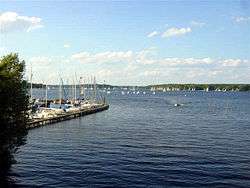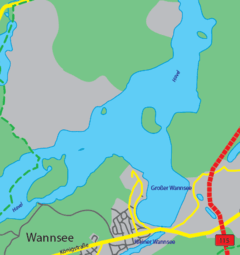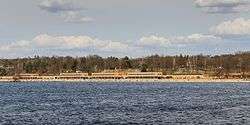Großer Wannsee
| Großer Wannsee | |
|---|---|
 | |
 map | |
| Location | Berlin |
| Coordinates | 52°26′36″N 13°9′41″E / 52.44333°N 13.16139°ECoordinates: 52°26′36″N 13°9′41″E / 52.44333°N 13.16139°E |
| Primary inflows | Havel |
| Primary outflows | Havel |
| Basin countries | Germany |
| Surface area | 2.732 km2 (1.055 sq mi) |
| Max. depth | 9 m (30 ft) |
| Surface elevation | 32 m (105 ft) |
| Settlements | Berlin-Wannsee |
The Großer Wannsee (Greater Wannsee) is a bight of the Havel river near the locality of Wannsee and Nikolassee (in the borough of Steglitz-Zehlendorf), a south-western suburb of the German capital Berlin not far from Potsdam. Between the river itself and the Wannsee lies the Breite, or Grosse Breite (Broad, or Great Broad).[1] To the north lies the island of Schwanenwerder and, opposite from the Greater Wannsee on the other side of the Havel, is the locality of Kladow (in Spandau).[2]
Overview
The Wannsee lake is well known as the number-one bathing and recreation spot for western Berlin, especially from a 1951 Schlager hit by teen idol Cornelia Froboess. The Strandbad Wannsee, an open-air lido with one of the longest inland beaches in Europe and a popular nudist area, was built in 1920–30 after a concept by architect Richard Ermisch.[3] Situated on the eastern shore of the lake it is officially part of the Nikolassee locality.
Photogallery

- View of the lake from Wannsee railway station
- Sunset on the lake
See also
- Kleiner Wannsee (Little Wannsee)
- Pfaueninsel
- Griebnitzsee
References
- ↑ Grosser Berliner Stadtplan, 1961, Verlag Richard Schwarz Nachf.
- ↑ Source: "ADAC StadtAtlas - Berlin-Potsdam". ed. 2007 - pages 192, 193, 228, 229 - ISBN 3-8264-1348-2
- ↑ (German) Historical infos and pictures on www.strandbadwannsee.de
External links
![]() Media related to Großer Wannsee at Wikimedia Commons
Media related to Großer Wannsee at Wikimedia Commons